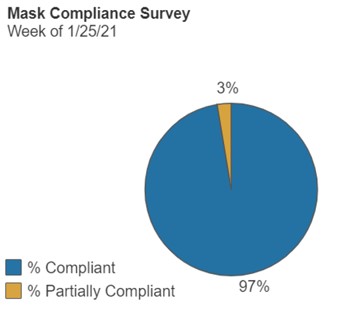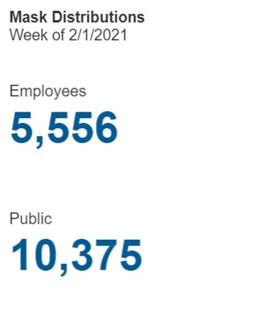By Kristen Holland
You may hear a new announcement on our vehicles or see new messages about masks being required by federal law. The spread of COVID-19 has led the federal government to enact a mask requirement for all public transportation conveyances. Here in San Francisco, that law means wearing a mask in Muni stations, when purchasing a ticket and while waiting for, boarding, riding or exiting transit. Failure to wear a mask can result in denial of boarding, removal from Muni and may carry federal penalties.
Muni customers are doing great when it comes to mask compliance, which consistently exceeds 95% (see chart). You get it. Wearing masks, physically distancing and riding Muni for only essential trips remain crucial to reducing the spread of COVID-19.

The SFMTA mask survey for the final week of January 2021 reported 97% compliance
And every week, our operators, fare inspectors and ambassadors hand out thousands of masks to those who don’t have one. Thank you for protecting our employees and each other.

During the first week of February 2021, the SFMTA distributed nearly 16,000 masks
Here’s more on the new law:
The federal mask requirement went into effect earlier this month and will continue until May 2021.
As a reminder, a properly worn mask:
- Completely covers the nose and mouth of the wearer
- Is secured to the head, including with ties or ear loops
- Fits snugly against the side of the face.
Face shields do not fulfill the requirements of the law. Instead, masks should be a solid piece of material without slits, exhalation valves, or punctures. Face coverings like scarves and bandanas do not meet this requirement. Visit the CDC website for tips on improving your mask to protect yourself and others.
Like other mask requirements, the law allows for some exemptions and exceptions. For example, the temporary removal of a mask is allowed in order to:
- Take oral medications for brief periods.
- Communicate with a person who is deaf or hard of hearing, when the ability to see the mouth is essential for communication.
The specifics of the federal law are outlined in the Transportation Security Administration Security Directive.
All state and local public health orders remain in effect. For more information, visit SFMTA.com/COVID or call 311 within San Francisco or 415-701-4311. Free language assistance available.
Published February 17, 2021 at 12:24AM
https://ift.tt/37nngSe
Nhận xét
Đăng nhận xét